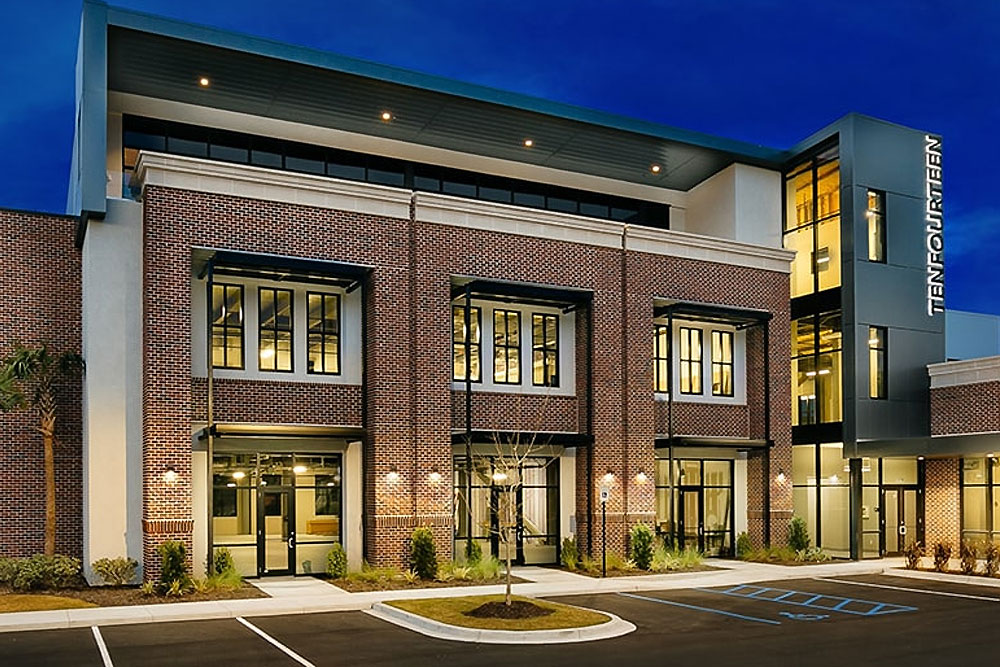Revealing the Comprehensive Providers Given by Commercial Architects for Modern Dope
Commercial Architects serve a critical function in modern growth jobs. They blend design aesthetic appeals with performance while sticking to governing needs. Their proficiency extends past simple construction, incorporating lasting methods and innovative technologies. As they browse intricate zoning legislations, Architects collaborate with numerous stakeholders to bring visions to life. This diverse method raises inquiries concerning the evolving duty of Architects fit modern spaces and the impact of their service future advancements.
Comprehending the Duty of Commercial Architects in Modern Advancement
In modern metropolitan landscapes, Commercial Architects play a critical function fit practical and visual areas that satisfy diverse organization requirements. Their knowledge extends past simple layout; they navigate complicated zoning laws, building codes, and environmental guidelines. By working together with clients, they recognize certain requirements, making certain that each job straightens with the client's vision while likewise taking into consideration practical elements such as sustainability and cost-effectiveness. Commercial Architects are experienced at integrating innovative innovations and products into their styles, boosting both the performance and power performance of buildings. They carry out comprehensive website evaluations to evaluate the possible obstacles and opportunities offered by a location. Furthermore, efficient interaction with contractors and other stakeholders is important, making certain that the project advances efficiently from conception to conclusion. Ultimately, Commercial Architects contribute in developing spaces that not only meet practical objectives yet additionally add to the total character and vibrancy of city settings.
Idea Layout: Transforming Ideas Into Fact
Principle design functions as a crucial phase in Commercial style, where ingenious design remedies arise from imaginative thinking. This procedure depends on collective ideation, combining diverse viewpoints to fine-tune and boost initial ideas. As concepts form, they transform from abstract ideas right into substantial building realities.
Innovative Style Solutions
Changing ideas into truth is the trademark of innovative layout remedies in Commercial style. These options blend creative thinking with capability, resolving the unique demands of modern developments. By leveraging innovative technologies and sustainable practices, Architects craft areas that are not just aesthetically appealing however likewise efficient and versatile. Focus on user experience drives the layout process, making certain that atmospheres foster productivity and cooperation. Each job take advantage of a tailored strategy, where ideas are thoroughly established to reflect the customer's vision while thinking about future fads. Ingenious design options also focus on flexibility, enabling modifications with time as organization demands progress. Eventually, these strategies improve the total value of Commercial areas, making them crucial in today's competitive landscape.

Joint Ideation Refine
Cooperation offers as the foundation of the ideation process in Commercial design, fostering creative thinking and innovation among diverse stakeholders. Architects, customers, designers, and neighborhood members engage in dynamic discussions, making sure that all point of views are considered. This comprehensive method enables the expedition of numerous layout principles, urging unique options that line up with the project's vision. Via workshops and conceptualizing sessions, ideas evolve and fine-tune, changing first concepts right into tangible designs. Modern technology also plays a pivotal duty, with tools such as Structure Information Modeling (BIM) promoting real-time partnership and adjustments. Eventually, this joint ideation procedure not only improves the layout result however likewise cultivates a sense of ownership and investment amongst all celebrations included, leading to successful Commercial advancements.
Zoning Analysis: Navigating Regulations and Conformity
As developers begin on brand-new tasks, comprehending zoning policies is vital to making certain compliance and preventing expensive hold-ups. Zoning analysis plays an essential function in this procedure, as it entails examining local zoning legislations that determine land usage, developing height, density, and troubles. Commercial Architects possess the know-how to browse these complex guidelines, aiding customers identify allowable uses and any type of necessary variations.
Sustainable Style Practices: Building for the Future
Lasting design techniques are increasingly important in the domain name of Commercial style, particularly as ecological problems continue to escalate. Architects prioritize environment-friendly materials, energy-efficient systems, and design methods that decrease waste and environmental influence. Incorporating renewable resource sources, such as photovoltaic panels and wind turbines, allows buildings to generate their own power and reduce dependence on fossil fuels.Furthermore, lasting design emphasizes the significance of indoor ecological top quality. This consists of using natural he has a good point light, boosting air flow, and selecting non-toxic materials to enhance occupant health and wellness and performance. Eco-friendly roofs and living wall surfaces are additionally popular attributes that add to biodiversity and city cooling.Additionally, Commercial Architects commonly incorporate water preservation methods, like rainwater harvesting and drought-resistant landscape design. Through these ingenious approaches, they develop areas that not only fulfill modern needs yet likewise promote a lasting future, addressing the expanding need for liable growth in the modern world.
Task Monitoring: Ensuring Timely and Reliable Implementation
Effective task management is essential for making certain that Commercial style projects are completed on schedule and within spending plan. This function encompasses a series of duties, including the control of different stakeholders, timelines, and sources. Commercial Architects take advantage of their experience to create comprehensive task strategies that outline critical turning points and deliverables, allowing for systematic progression tracking.Regular communication among staff member and clients is essential, cultivating transparency and assisting in punctual decision-making. Threat administration strategies are also utilized to determine possible challenges early, allowing aggressive solutions to be established. By using sophisticated task management devices, Architects can keep an eye on project efficiency in real-time, making modifications as needed to keep performance.
Inside Design: Creating Useful and Visual Spaces
Interior decoration plays a vital role in boosting both capability and visual appeal within Commercial spaces. Efficient room planning can enhance operations and enhance user experience, while visual design principles add to a visually appealing environment - commercial architects. Together, these elements create spaces that are not only practical but additionally motivating
Room Preparation Effectiveness
While maximizing the utility of readily available space, Commercial Architects prioritize area preparation performance to create both functional and cosmetically pleasing settings. This method includes mindful analysis of the spatial design to ensure optimal use every square foot. Architects take into consideration factors such as operations, accessibility, and all-natural light to improve functionality. By tactically putting furniture, equipment, and workstations, they help with activity and interaction among users, advertising efficiency. Additionally, zoning different areas for particular functions helps in managing sound and personal privacy, developing a harmonious ambience. With effective area planning, Commercial Architects can change constraints into opportunities, making sure that each area satisfies the diverse requirements of its residents while sticking to regulative needs and market pop over to this site criteria.
Visual Design Principles
Aesthetic layout concepts play an important duty in forming atmospheres that are not just functional yet likewise visually appealing. These concepts direct Commercial Architects in developing areas that reverberate with users while improving brand name identity. Trick aspects consist of equilibrium, proportion, and harmony, which function with each other to develop a natural appearance. Color pattern and products are meticulously picked to stimulate wanted feelings and sustain the overall theme. Furthermore, lighting plays an essential role, influencing mood and visibility while highlighting architectural functions. By integrating these principles, Architects ensure that rooms are not only useful yet also welcoming and inspiring. Ultimately, effective visual design cultivates a positive user experience, motivating engagement and satisfaction in Commercial settings.
Cooperation With Stakeholders: Promoting Successful Collaborations
Successful partnerships in Commercial style hinge on reliable partnership with stakeholders, making certain that every voice is heard and valued. This joint strategy involves appealing different parties, consisting of clients, service providers, and community participants, throughout the style and growth procedure. By fostering open communication, Commercial Architects can attend to worries, gather insights, and line up the job's vision with stakeholder expectations.The assimilation of diverse viewpoints boosts creative thinking and innovation, leading to even more practical and visually pleasing designs. Normal meetings, feedback sessions, and workshops promote this dialogue, permitting Architects to adjust their plans in response to stakeholder input. On top of that, establishing trust fund with openness and liability reinforces these partnerships, resulting in a smoother task execution.Ultimately, the success of modern-day growths depends upon the Architects' capacity to navigate and integrate differing interests, producing a collaborative atmosphere that advertises shared goals and common success.
Frequently Asked Inquiries
Exactly How Do Commercial Architects Take Care Of Spending Plan Constraints During a Task?

What Kinds of Software Program Do Commercial Architects Generally Make Use Of?
Commercial Architects frequently use software program such as AutoCAD for drafting, Revit for Building Info Modeling, SketchUp for 3D modeling, and project administration devices like Microsoft Job to boost partnership and improve workflows throughout the layout process.
Can Commercial Architects Assist With Obtaining Funding for Projects?
Commercial Architects can assist in obtaining funding for tasks by preparing thorough propositions, helping to express layout visions, and providing financial forecasts that can improve the likelihood of safeguarding look at here essential funding from financiers or banks.
Exactly How Do Architects Ensure Safety And Security Throughout the Building And Construction Process?
Architects assure security throughout construction by executing strenuous style criteria, coordinating with designers, performing normal site assessments, adhering to neighborhood policies, and promoting interaction amongst all stakeholders to reduce dangers and promote a protected workplace.
What Continuous Support Do Architects Provide After Job Completion?
After task completion, Architects offer ongoing assistance through upkeep assessments, efficiency evaluations, and design alterations. They assure structures fulfill developing demands, address potential problems, and keep compliance with regulations, cultivating a long-term partnership with clients.
Comments on “Why commercial architects Optimize Usable Areas in Tight Urban Locations”